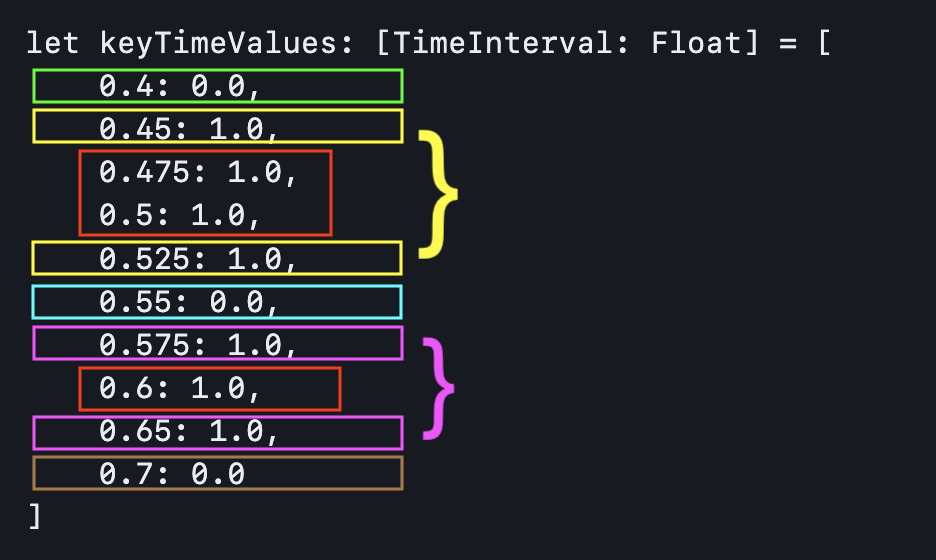Last active
July 1, 2024 14:07
-
-
Save AvdLee/0ff618b7d149be631050994ee8246bff to your computer and use it in GitHub Desktop.
KeyTimeValues Coding Challenge
This file contains hidden or bidirectional Unicode text that may be interpreted or compiled differently than what appears below. To review, open the file in an editor that reveals hidden Unicode characters.
Learn more about bidirectional Unicode characters
| let keyTimeValues: [TimeInterval: Float] = [ | |
| 0.4: 0.0, | |
| 0.45: 1.0, | |
| 0.475: 1.0, | |
| 0.5: 1.0, | |
| 0.525: 1.0, | |
| 0.55: 0.0, | |
| 0.575: 1.0, | |
| 0.6: 1.0, | |
| 0.65: 1.0, | |
| 0.7: 0.0 | |
| ] | |
| /// The challenge: | |
| /// The keys represent animation key times, the values represent values. Some key times repeat the same value of the previous keytime. | |
| /// How would you reduce the above dictionary in such way that the values do not repeat themselves | |
| /// more than once? | |
| /// For example, this group: | |
| /// 0.45: 1.0, | |
| /// 0.475: 1.0, | |
| /// 0.5: 1.0, | |
| /// 0.525: 1.0, | |
| /// | |
| /// The keytime 0.475 and 0.5 don't change the value and are, therefore, redundant in key frame animations. | |
| /// | |
| /// Expected outcome: | |
| let expectedOutcome: [TimeInterval: Float] = [ | |
| 0.4: 0.0, | |
| 0.45: 1.0, | |
| 0.525: 1.0, | |
| 0.55: 0.0, | |
| 0.575: 1.0, | |
| 0.65: 1.0, | |
| 0.7: 0.0 | |
| ] |
@KieranConlon : Thank you !!
@AvdLee It's my solution:
let keyTimeValues: [TimeInterval: Float] = [
0.4: 0.0,
0.45: 1.0,
0.475: 1.0,
0.5: 1.0,
0.525: 1.0,
0.55: 0.0,
0.575: 1.0,
0.6: 1.0,
0.65: 1.0,
0.7: 0.0
]
extension Dictionary<TimeInterval, Float>{
func optmizedDict() -> Dictionary<TimeInterval, Float>{
var tempElement: Dictionary<TimeInterval, Float>.Element? = nil
return reduce([:]) { partialResult, element in
var partialResult = partialResult
if element.value != tempElement?.value && tempElement != nil {
partialResult[tempElement!.key] = tempElement!.value
partialResult[element.key] = element.value
}
tempElement = element
return partialResult
}
}
}
let result = keyTimeValues.optmizedDict().sorted{$0.0 < $1.0}
import Foundation
final class LinkedList: CustomStringConvertible {
private final class Node {
let timing: TimeInterval
let value: Float
var next: Node?
init(timing: TimeInterval, value: Float) {
self.timing = timing
self.value = value
}
}
private var head: Node?
private var tail: Node?
func append(timing: TimeInterval, value: Float) {
let newNode = Node(timing: timing, value: value)
if let tailNode = tail {
if tailNode.value != newNode.value {
tailNode.next = newNode
tail = newNode
}
} else {
head = newNode
tail = newNode
}
}
var description: String {
var result = ""
var current = head
while let node = current {
result = result.isEmpty
? "[timing:\(node.timing), value:\(node.value)]"
: "\(result) → [timing:\(node.timing), value:\(node.value)]"
current = node.next
}
return result
}
}
// Example usage
let keyTimeValues: [TimeInterval: Float] = [
0.4: 0.0,
0.45: 1.0,
0.475: 1.0,
0.5: 1.0,
0.525: 1.0,
0.55: 0.0,
0.575: 1.0,
0.6: 1.0,
0.65: 1.0,
0.7: 0.0
]
var list = LinkedList()
keyTimeValues.sorted { $0.key < $1.key }.forEach { (key: TimeInterval, value: Float) in
list.append(timing: key, value: value)
}
Sign up for free
to join this conversation on GitHub.
Already have an account?
Sign in to comment
If you have a repeating value, then keep the first and last instance of that value.

Not sure if this colour-coded version helps; essentially remove the values within the red boxes.